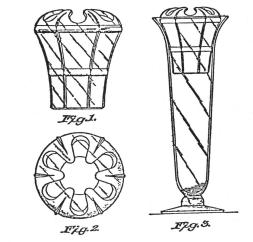Flower Holders - Part VII
by Bill Smith
Issue 33 - January 1976
The flower holder that we present this month is one that is considerably different from holders that we have shown in the past. It should, however, prove to be very interesting to those of you that are seeking the unusual pieces of Cambridge glass.
 It was oalled a Flower Vase Insert, and all of the advertising and
catalog references that we have found have used this description. To
date we have found no numbers associated with it.
It was oalled a Flower Vase Insert, and all of the advertising and
catalog references that we have found have used this description. To
date we have found no numbers associated with it.
We have been very fortunate in the amount and scope of the Information that we have found for this article. Probably more than for any other of the holders described in previous articles.
These drawings, taken from the patent applications, are fairly self explanatory. Fig. 1 is the side view of the article, Fig. 2 is a view down at the top, and Fig. 3 shows how this item fits down into a vase.
Mr. A. J. Bennett applied for and received three separate patents for this article. He patented the design, his method of manufacture, and the article itself.
His application for the design patent was filed on March 12, 1924 and the patent was granted on May 20, 1924 under Design 64,652 for a period of fourteen years. The application for production of his method of making these items was also filed on March 12, 1924. It wan not granted, however, until November 9, 1926, when number 1,606,687 was assigned. The patent for the article itself was filed a few days later on March 27, 1924 and was granted on May 26, 1925 under number 1,539,153.
One interesting fact that came out of our study was that Mr. Bennett was not one to wait when a good item was developed. The March 31, 1924 issue of China, Glass and Lamps carried a cover ad which pictured this article and suggested that everyone who sells vases should carry this very desirable item in stock.
According to the application for Patent number 1,606,687, (method for making ...) the articles were made in a two part mold which appeared to be very similar to a tumbler mold. The fingers or spikes that constitute the flower retainers were in a vertical plane. After molding, the article was placed in a Snap (a tool for holding partially completed ware) and reheated, whereupon the spikes were turned over with a wooden paddle to assume the position of the finished product as shown in Fig. 1. The article was then allowed to partially cool, tempered, the bottom cracked off and ground. This multi-step operation would complete the article.
The patent applications claim that when using an insert of this nature a half-dozen flowers can be arranged in regulable spaced order so as to present the same mass appearance as would be presented were a considerably greater number of flowers arranged in a vase and directly supported by or against the mouth or top of the vase. They further claim that it is a device of character which is attractive and ornamental that contributes to and enhances the appearance of the vase as well as the flowers.
For those of you that have Welker Reprint catalog #1, this article appears in the vases shown on page 90. This page shows three sizes which include 2 7/8 in., 3¼ in., and 5½ in.
To date, the only insert that we have heard of is one owned by Mr. Paul Roberts, who sends us this additional information. "The one that he owns is in crystal and is 2 7/8 in. This measurement is the height not width. It is acid marked with the inscription 'Patent Applied For', and hence a date of March 1924." We are not clear as to whether the date is acid or mold mark.
There are perhaps two reasons why this particular item has not been seen more often. It would appear that it might have boon very susceptible to breakage and there has been nothing to give us a clue to the fact that it was Cambridge.
